As you explore Agra, you'll uncover a treasure trove of architectural wonders! The Taj Mahal's white marble shines like a beacon, while Agra Fort's red sandstone showcases Mughal grandeur. Mehtab Bagh's tranquil atmosphere and stunning sunset views await, and Fatehpur Sikri's royal palaces boast intricate frescoes. Discover the vibrant cultural heritage of Jama Masjid's ornate architecture, and get ready to uncover many more hidden gems in this historic city. But that's just the beginning – as you venture deeper, you'll unravel a rich tapestry of beauty, craftsmanship, and history that will leave you enchanted.
Key Takeaways
- The Taj Mahal, a stunning white marble mausoleum, is a must-visit monument and a symbol of love and devotion.
- Agra Fort, a UNESCO World Heritage Site, showcases the blending of Islamic and Hindu architectural styles.
- Mehtab Bagh, a tranquil Mughal garden, offers breathtaking views of the Taj Mahal, especially during sunset.
- Fatehpur Sikri's Royal Palaces feature intricate Mughal-era frescoes, showcasing artistic brilliance and historical importance.
- Jama Masjid, a beautiful mosque, showcases Islamic design and Mughal-era craftsmanship, with delicate carvings and intricate arches.
Taj Mahal's White Marble
As you step into the Taj Mahal, you'll be mesmerized by the radiant white marble that seems to shimmer in the light. You're about to uncover the secrets behind this stunning monument's majestic beauty, from the intricate inlays of precious stones to the extraordinary polishing that makes it glow. Get ready to explore the Taj Mahal's white marble up close, and discover the fascinating details that make it an unforgettable experience.
Overview
Standing before the Taj Mahal, you're immediately struck by the radiant beauty of its white marble, a masterpiece of Mughal architecture that shines like a beacon, beckoning you to uncover the secrets of its mesmerizing allure. As you gaze upon the Taj's exterior, you'll notice the intricate inlays of precious stones, including jasper, jade, and turquoise, which were sourced from across the world. The marble itself is made of high-quality Makrana marble, sourced from Rajasthan, India. What's more, the Taj's white marble is not just a single hue – it changes color depending on the time of day and lighting conditions, appearing pinkish in the morning, white at noon, and golden in the evening. This stunning visual effect is a demonstration of the ingenuity of Mughal architects, who seamlessly blended Indian culture with Persian and Islamic influences. With its intricate designs and ornate patterns, the Taj Mahal's white marble is a true marvel of Mughal history, a symbol of love and devotion that continues to captivate visitors from around the world.
Majestic Marble Dome Interior
You step inside the Taj Mahal, and the majestic marble dome interior envelops you in its serene beauty, the intricate inlays and ornate patterns of the white marble appearing even more breathtaking up close. As you wander through the halls, you can't help but marvel at the stunning architecture, a blend of Indian, Persian, and Islamic styles that creates a unique and striking visual language. The Taj Mahal's interior is a masterclass in opulence, with intricately carved marble screens, delicate filigree work, and ornate calligraphy adorning the walls. It's no wonder that this magnificent monument has inspired countless museum exhibits and art installations around the world. The attention to detail is staggering, with every aspect of the interior design carefully considered to create a sense of harmony and balance. As you explore the Taj Mahal's majestic marble dome interior, you'll discover a world of beauty, craftsmanship, and architectural innovation that will leave you awestruck.
Best Time To Visit
Timing is everything when it comes to visiting the Taj Mahal, and knowing the best time to visit this stunning monument can make all the difference in your experience, allowing you to fully appreciate the radiant beauty of its white marble.
The best time to visit the Taj Mahal is from October to March, when the weather forecast is mild and pleasant, making it ideal for sightseeing. This is considered the peak tourist season, and you can expect large crowds, but the climate conditions are perfect for exploring the monument. During this time, you can enjoy seasonal activities like the Taj Mahotsav, a cultural festival that celebrates the beauty of the Taj.
However, if you're looking for a more relaxed experience, consider visiting during the off-season, from April to September. Keep in mind that the weather can be hot and humid, and there may be travel restrictions due to safety concerns. Before planning your trip, be sure to check the weather forecast and travel advice to guarantee a smooth and enjoyable journey.
Wear Comfortable Walking Shoes
As you explore the majestic Taj Mahal, don't let discomfort distract you from its breathtaking beauty – make sure to wear comfortable walking shoes that can handle the demands of this stunning monument. The Taj's white marble flooring can be scorching hot during peak summer months, so prioritize Foot Care and wear shoes that provide adequate protection for your feet. With the complex spanning 42 acres, you'll be doing a lot of walking, making sturdy and comfortable shoes a must-have. Additionally, the flooring can be slippery, especially when wet, so opt for shoes with good grip to avoid accidents. When entering the main mausoleum, you'll need to remove your shoes, so choose ones that are easy to slip on and off. Finally, the complex's uneven and rough surfaces require shoes that provide adequate ankle support and protection. By following these Walking Tips, you'll be able to fully appreciate the Taj's grandeur without any discomfort holding you back.
Agra Fort's Red Sandstone
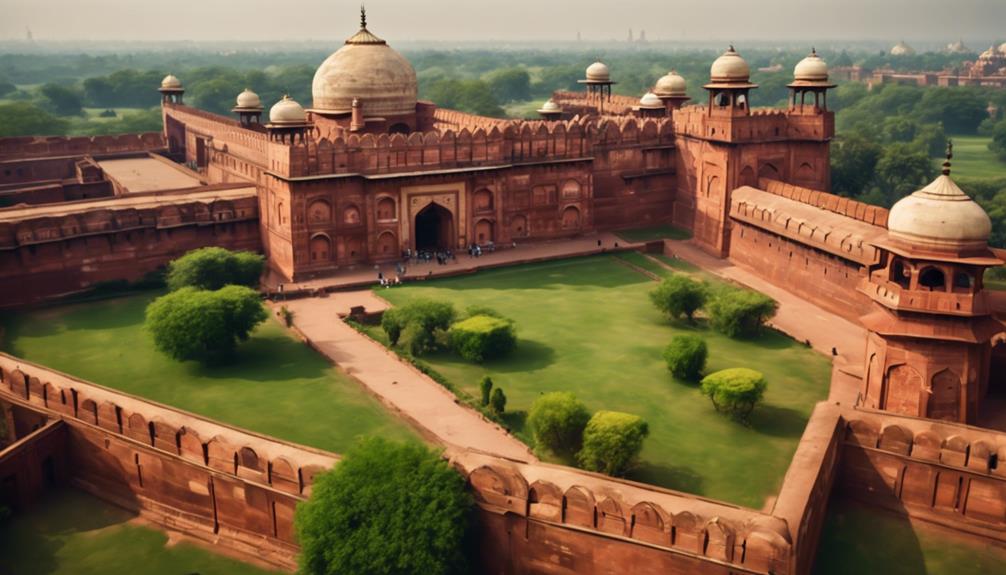
As you step into the majestic Agra Fort, you're immediately struck by the warm, rusty hue of its red sandstone walls, which seem to glow with a life of their own. You'll want to linger awhile, taking in the intricate carvings and ornate details that adorn the fort's imposing architecture. As you explore this Mughal-era marvel, be sure to plan your visit wisely and protect yourself from the sun's strong rays.
Overview
Built from the rich, crimson-hued red sandstone that would become a hallmark of Mughal architecture, Agra Fort stands as a monument to the grand vision of Emperor Akbar, who commissioned this majestic monument in the 16th century. As you walk through the fort's majestic gates, you'll be struck by the sheer scale and historic significance of this UNESCO World Heritage Site. The fort's architectural evolution is a reflection of the blending of Islamic and Hindu styles, with intricate carvings, ornate decorations, and majestic gateways that will leave you in awe. With over 4,000 workers laboring for eight years to complete the fort in 1573, it's no wonder that Agra Fort is a masterclass in architectural grandeur. As you explore the fort complex, you'll discover impressive structures like the Diwan-i-Am, Diwan-i-Khas, and the Macchi Bhavan, which were used for administrative and ceremonial purposes. Situated on the right bank of the Yamuna River, Agra Fort offers breathtaking views of the Taj Mahal, another iconic Mughal monument.
Intricate Mughal-Era Stone Carvings
Step into Agra Fort's majestic halls and you're immediately struck by the intricate Mughal-era stone carvings that adorn the walls and ceilings, a tribute to the mastery of Mughal craftsmen who carefully chiseled away at the prized red sandstone to create breathtaking works of art. As you gaze upon these masterpieces, you'll notice the intricate geometric patterns, Arabic calligraphy, and floral motifs that showcase the cultural exchange and synthesis of Indian, Persian, and Islamic artistic traditions. The carvings are not only aesthetically pleasing but also tell the story of the Mughal Empire's history, with many depicting scenes from royal life, battles, and mythological stories. The remarkable preservation of these carvings, dating back to the 16th and 17th centuries, is a tribute to the skill and craftsmanship of the Mughal-era artisans. This artistic legacy is a significant part of Agra Fort's cultural significance, offering a glimpse into the region's rich history and cultural heritage. As you explore the fort, you'll be struck by the enduring beauty and craftsmanship of these intricate stone carvings, a true marvel of Mughal-era artistry.
Best Time To Visit
You're likely wondering when to plan your visit to marvel at Agra Fort's majestic red sandstone beauty, and the answer lies in understanding the region's climate and tourist seasons. Agra's weather forecast is characterized by hot summers and mild winters, making it a year-round destination. However, the best time to visit Agra Fort is from October to March, when the temperatures are mild and comfortable, ranging from 12°C to 25°C. During this period, the weather is ideal for sightseeing, and you can explore the fort's intricate stone carvings and majestic architecture without the scorching heat.
The peak tourist season in Agra is from December to January, when the weather is at its coolest. If you're looking to avoid the crowds, consider visiting during the shoulder season from April to June or September to November. Keep in mind that the summer months from April to June can be extremely hot, with temperatures often soaring above 40°C. By planning your visit according to the weather forecasts and tourist seasons, you'll be able to make the most of your trip to Agra Fort and truly appreciate its stunning red sandstone beauty.
Wear Sunscreen and Hats
As you wander through Agra Fort's sprawling complex, the intense Indian sun beating down on the red sandstone walls will leave you grateful for every ounce of sun protection you've packed. With the fort's towering walls reaching up to 70 feet high, the sun's rays can be unforgiving. Don't let the excitement of exploring this UNESCO World Heritage Site distract you from prioritizing sun safety.
Remember to slather on broad-spectrum sunscreen with a high SPF, and reapply every two hours or immediately after swimming or sweating. A wide-brimmed hat will not only protect your face and neck but also add a stylish touch to your summer travel ensemble. Don't forget to pack a lightweight, breathable scarf to cover your neck and ears when the sun is at its strongest. These summer travel essentials will allow you to focus on soaking up the history and architecture of Agra Fort, rather than worrying about sunburn. By following these sun protection tips, you'll be free to marvel at the intricate carvings and majestic arches without compromising your skin's health, and guarantee that you can fully appreciate the beauty of this ancient site.
Mehtab Bagh Sunset View
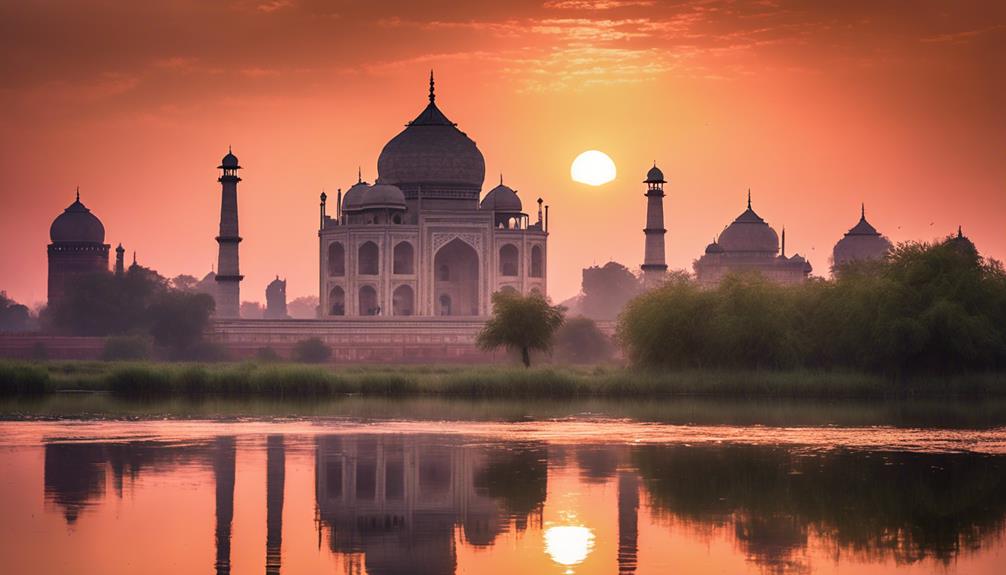
As you explore Mehtab Bagh, you'll discover a tranquil oasis that's a perfect complement to the Taj Mahal's grandeur. Here, you can unwind and take in the breathtaking views of the Taj Mahal, especially during sunset when the monument is bathed in a warm, golden light. Let's explore the highlights of Mehtab Bagh, from its stunning garden fountains display to the best times to visit and tips on avoiding the crowds.
Overview
Perched on the opposite side of the Yamuna River, Mehtab Bagh offers a serene and picturesque escape, its quadrilateral garden layout unfolding like a tranquil oasis amidst the bustle of Agra. As you stroll through the gardens, you'll be struck by the stunning views of the Taj Mahal, especially during sunset when the sky is painted with hues of orange and pink.
Mehtab Bagh is a char bagh, a traditional Mughal garden design inspired by the Quran, with its symmetrical layout reflecting the beauty of the Taj Mahal. Built by Emperor Babur in 1530, it's one of the oldest Mughal gardens in India, originally designed as a resting place for travelers. The garden's tranquil atmosphere makes it an ideal spot for picnics, relaxation, and taking in the breathtaking views. As you explore Mehtab Bagh, you'll appreciate the rich history and stunning architecture that make this hidden gem a must-visit attraction in Agra.
Stunning Garden Fountains Display
While strolling through Mehtab Bagh's quadrilateral gardens, you'll discover the stunning garden fountains display, which becomes even more breathtaking during sunset when the golden light of the setting sun highlights the water features, creating a mesmerizing display of beauty and serenity. The symmetrical design of the garden, inspired by the Quran, is reflected in the fountain design, adding to the overall aesthetic appeal. As you walk along the pathways, you'll notice the beautifully crafted water features, which are an integral part of the garden's charm. The sound of gently flowing water and the soft chirping of birds create a soothing atmosphere, making it an ideal spot to relax and unwind. The fountain display is particularly striking during sunset, when the golden light of the setting sun casts a warm glow on the water features, creating a truly magical experience. With its unique blend of natural beauty and architectural charm, Mehtab Bagh's garden fountains display is a must-see attraction in Agra.
Best Time To Visit
Timing your visit to Mehtab Bagh to coincide with sunset is essential to fully experiencing the majesty of the garden's fountain display. As you plan your trip, consider the best time to visit this stunning garden. The Monsoon season, from July to September, brings lush greenery and a rejuvenating atmosphere, making it an ideal time to explore Mehtab Bagh. If you're looking for a more relaxed experience, avoid the Summer holidays when the garden is bustling with tourists. Instead, take advantage of off-season deals from April to June or October to November, when the weather is pleasant and the tourist rush is minimal. Be sure to check the weather forecast before your visit to guarantee a comfortable and enjoyable experience. If you don't mind the crowds, peak season from December to March is a great time to visit, with comfortable temperatures and a lively atmosphere. Whatever time you choose to visit, Mehtab Bagh's beauty is sure to leave you in awe.
Avoid Peak Sun Hours
As you plan your visit to Mehtab Bagh, consider the sun's intense rays during peak hours, and make sure to schedule your trip to coincide with the serene ambiance of the sunset view. You'll want to avoid the scorching heat of the day, when the sun beats down relentlessly, making it challenging to fully appreciate the beauty of this majestic garden. Instead, plan your visit for early morning or late afternoon, when the sun's rays are gentler and the atmosphere is more tranquil. Don't forget to apply a generous layer of sunscreen, even on cloudy days, to protect your skin from the sun's harmful UV rays. By visiting during these times, you'll be able to take in the breathtaking views of the Taj Mahal, situated just across the Yamuna River, without the distraction of the blistering sun. Take a leisurely morning exploration of the gardens, and then settle in to watch the sunset over the Taj, with the Yamuna River flowing gently in the foreground.
Fatehpur Sikri's Royal Palaces
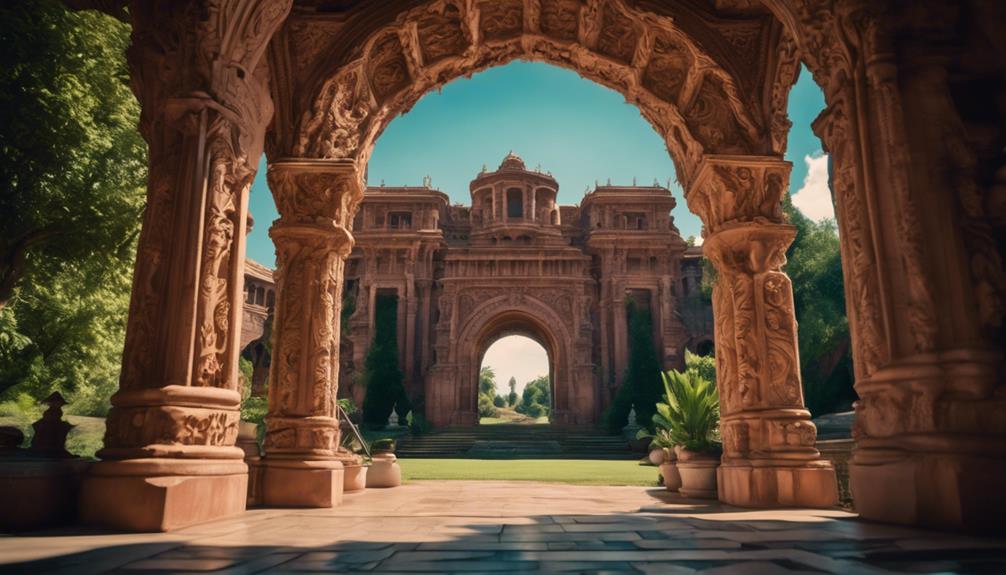
As you step into Fatehpur Sikri's Royal Palaces, you'll be surrounded by the majestic remnants of Mughal Emperor Akbar's capital city. You'll have the chance to explore the intricate architecture, ornate decorations, and rich history of the palace complex, which will leave you in awe. From the stunning frescoes to the best times to visit, get ready to uncover the secrets of this breathtaking monument.
Overview
As you step into Fatehpur Sikri's Royal Palaces, you're instantly immersed in a majestic blend of Islamic and Hindu architectural styles, with intricate carvings, ornate decorations, and majestic arches that transport you to the 16th century, when Mughal Emperor Akbar built this capital city. You can't help but feel the grandeur of Mughal history as you explore the sprawling complex, a reflection of Akbar's vision of a multicultural and tolerant society. The palace's unique blend of styles reflects Akbar's legacy of secularism and liberalism, showcasing his ability to bring people together.
As you wander through the complex, you'll discover majestic structures like the Diwan-i-Khas, a hall of private audience, and the Diwan-i-Am, a hall of public audience. The Panch Mahal, a five-story palace with 176 columns, is another marvel. And then there's the imposing Buland Darwaza, a 54-meter-high gateway that serves as the main entrance to the palace. Every aspect of the Royal Palaces is a tribute to Akbar's innovative spirit and his desire to create a harmonious society.
Intricate Mughal-Era Frescoes Remain
Stepping into the opulent halls of Fatehpur Sikri's Royal Palaces, you're immediately struck by the kaleidoscope of colors and intricate patterns that adorn the walls, a tribute to the artistic brilliance of Mughal-era artisans who crafted these exquisite frescoes. The significance of these frescoes lies not only in their beauty but also in their historical importance, offering a glimpse into the artistic and cultural practices of the Mughal era. The artisanal craftsmanship on display is truly remarkable, with skilled artisans having used a range of materials, including limestone, marble, and ceramic tiles, to create these masterpieces. As you wander through the palace, you'll notice the frescoes are adorned with intricate calligraphy, often featuring passages from the Quran, and showcase a vibrant color palette, featuring blues, reds, and golds. The frescoes in the Diwan-i-Khas, or Hall of Private Audiences, are particularly exceptional, featuring elaborate designs and patterns that reflect the Mughal's love of luxury and opulence.
Best Time To Visit
Timing is everything when planning a visit to Fatehpur Sikri's Royal Palaces, and you'll want to synchronize your trip with the gentle winter months, from October to March, when the climate is mild and comfortable. During this time, the weather forecast is usually sunny with average temperatures ranging from 10°C to 25°C, making it ideal for exploring the majestic architecture and intricate frescoes. Avoid the sweltering summer heat from April to June, when temperatures can soar up to 45°C, and the monsoon season from July to September, which brings heavy rainfall and humid conditions. You'll also want to steer clear of the peak tourist season during the holiday season, when tourist crowds flock to the site, making it difficult to fully appreciate the grandeur of the Royal Palaces. With climate change affecting global weather patterns, it's crucial to stay updated on the latest weather forecast to guarantee a smooth and enjoyable trip. By planning your visit during the winter months, you'll be able to take in the beauty of Fatehpur Sikri's Royal Palaces without the distractions of large crowds and extreme weather conditions.
Wear Comfortable Walking Sandals
With the best time to visit Fatehpur Sikri's Royal Palaces sorted, it's time to think about what you'll wear on your feet, because you'll be doing a lot of walking on uneven stone floors and climbing stairs to explore the majestic complex. You'll want to prioritize comfort and practicality, so ditch those stylish but impractical shoes for a pair of comfortable walking sandals. These palaces, a UNESCO World Heritage Site, span over 3 miles, and you'll be doing a lot of walking to take in the intricate stone carvings and ornate decorations of the Diwan-i-Khas and Diwan-i-Am. Trust us, you won't want to sacrifice your comfort for the sake of style. Opt for sandals that are sturdy, breathable, and provide excellent arch support. With the right footwear, you'll be able to focus on the architectural marvels and historical significance of Fatehpur Sikri's Royal Palaces without any discomfort or distractions. Remember, this is a sand-friendly outing, and comfortable footwear is an essential part of your sand-friendly arsenal. So, pack those comfortable walking sandals and get ready to explore one of Agra's most breathtaking attractions.
Jama Masjid's Ornate Architecture

As you step into the majestic Jama Masjid, you're immediately struck by the stunning architecture that surrounds you. You can't help but marvel at the intricate details that adorn the walls and ceilings, showcasing the mastery of Islamic design. From the moment you enter, you'll want to explore every nook and cranny, uncovering the secrets and stories hidden within the mosque's ornate architecture.
Overview
Step into the majestic Jama Masjid, and you'll be struck by the intricate inlays of marble and jasper that adorn its ornate architecture, a demonstration to the craftsmanship of the Mughal era. As you explore the mosque, you'll uncover the rich Agra history that permeates every brick and stone. The Jama Masjid's cultural significance is palpable, standing as a monument to the city's storied past.
As you wander through the mosque's sprawling complex, you'll notice the perfect blend of Islamic and Indian architectural styles. The delicate carvings, intricate arches, and majestic domes all come together to create a visual feast. The mosque's sheer scale is awe-inspiring, with its vast courtyard and towering minarets that seem to touch the sky.
The Jama Masjid is more than just a beautiful monument – it's a window into Agra's vibrant history and cultural heritage. As you explore deeper into the mosque's ornate architecture, you'll uncover the stories of the city's past, from the grandeur of the Mughal Empire to the quieter moments of devotion and contemplation.
Intricate Islamic Calligraphy
You'll be mesmerized by the intricate Islamic calligraphy that adorns the walls and ceilings of Jama Masjid, its elegant Arabic script weaving a narrative of devotion and spirituality. As you walk through the mosque's ornate architecture, you'll notice the intricate patterns and designs that seem to come alive. The Arabic typography is a reflection of the skill of the artisans who crafted these masterpieces centuries ago. You can almost hear the whispers of the muezzin, calling the faithful to prayer, as you gaze upon the beautifully rendered verses from the Quran.
The Islamic manuscripts that inspired these works of art are a tribute to the rich cultural heritage of the region. You can't help but be struck by the level of craftsmanship that has gone into creating these stunning examples of Islamic calligraphy. Every curve and flourish seems to have been carefully considered, every stroke a masterpiece of precision and beauty. As you stand in awe of Jama Masjid's ornate architecture, you'll realize that you're not just looking at a building – you're experiencing a living, breathing monument to the power of faith and art.
Best Time To Visit
Timing is everything when exploring Jama Masjid's ornate architecture, and the best time to visit is during the early morning or late afternoon when the golden light of sunrise or sunset accentuates the intricate Islamic calligraphy and ornate patterns that adorn the walls and ceilings. As you plan your visit, consider the seasonal festivals and holiday calendars that bring this historic mosque to life. During the winter months, the cooler climate makes it an ideal time to explore the complex, while the summer heat can be intense, so be sure to check the weather forecasts before heading out. If you're looking to avoid the crowds, consider visiting during the off-season, when the tourist seasons are slower and you can take in the serene atmosphere. Be mindful of climate changes and how they may impact your visit, and plan accordingly. By timing your visit just right, you'll be able to fully appreciate the breathtaking beauty of Jama Masjid's ornate architecture.
Respectful Dress Code Required
As you prepare to immerse yourself in the stunning beauty of Jama Masjid's ornate architecture, remember to dress modestly, covering your shoulders, chest, and knees as a sign of respect for the sacred space. This historic mosque, built by Shah Jahan in 1648, is a reflection of the rich cultural heritage of Agra. As you walk through its majestic gates, you'll be surrounded by intricate marble inlays, ornate carvings, and stunning calligraphy. But before you step into this magnificent structure, take a moment to appreciate the cultural sensitivity and religious norms that govern this sacred space.
Anguri Bagh's Royal Pavilions
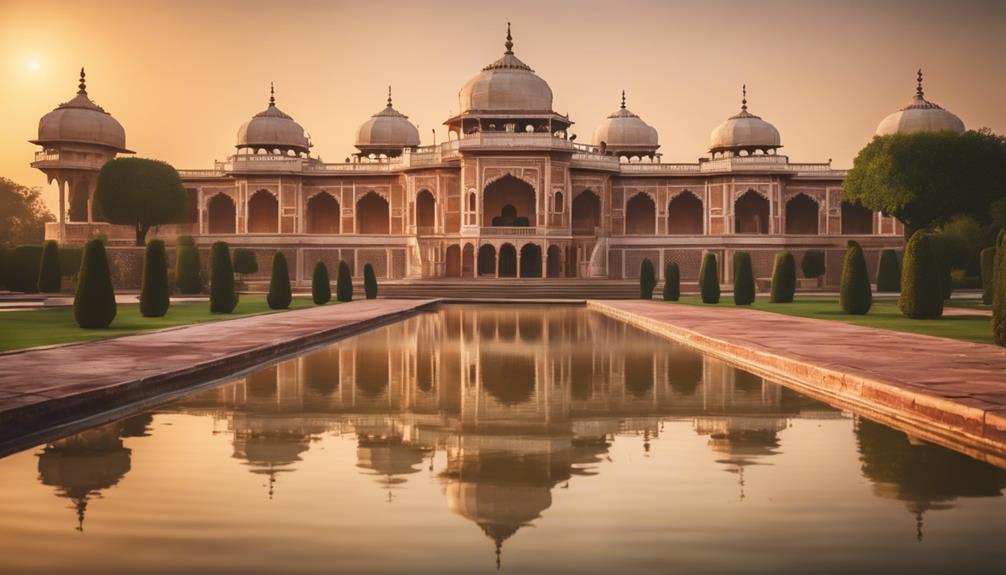
As you step into Anguri Bagh's Royal Pavilions, you'll be surrounded by the majestic beauty of Mughal architecture. You'll soon discover the intricate details that make this historic site a must-visit in Agra, from the stunning royal marble inlays to the perfect times of year to explore the grounds. As you prepare to explore this majestic site, remember to wear comfortable walking sandals, and get ready to uncover the secrets of Anguri Bagh's Royal Pavilions.
Overview
What secrets lie hidden behind the intricately carved walls of Anguri Bagh's Royal Pavilions, waiting to be uncovered by curious travelers like you? As you step into this majestic complex, you'll be transported back in time, immersing yourself in Agra's rich history. The Royal Pavilions, a monument to the city's grandeur, whisper tales of the Mughal Empire's opulence and extravagance.
As you wander through the pavilions, the scent of local cuisine wafts through the air, tantalizing your taste buds and tempting you to indulge in the region's famous delicacies. Savor the flavors of Agra's culinary heritage, a delicious blend of spices, herbs, and love. Let the intricate carvings, ornate furnishings, and majestic architecture transport you to an era of regal splendor.
Every nook and cranny of Anguri Bagh's Royal Pavilions holds a story, waiting to be unearthed by curious explorers like you. Unravel the mysteries hidden within these ancient walls, and let Agra's history come alive before your eyes.
Royal Marble Inlays
Step into the resplendent Royal Pavilions of Anguri Bagh, where the majestic marble inlays, crafted from thousands of tiny pieces of precious stones, await your discovery, telling the tale of a bygone era of unparalleled craftsmanship and opulence. As you marvel at the intricate designs, you'll witness the epitome of Mughal craftsmanship, where skilled artisans spent over 22 years perfecting their art. The stone arrangement is a demonstration of their ingenuity, with over 30 types of precious and semi-precious stones, including jasper, jade, and turquoise, carefully arranged to create intricate floral patterns and geometric designs. It's astonishing to think that over 1,000 workers were involved in this monumental project, showcasing the grandeur of the Mughal Empire during its peak in the 17th century. As you wander through the Royal Pavilions, you'll be struck by the sheer scale and beauty of the marble inlays, a true masterpiece of Mughal architecture and craftsmanship.
Best Time To Visit
You'll want to plan your visit to Anguri Bagh's Royal Pavilions strategically, considering the harsh Indian summers and chilly winters, to fully appreciate the majestic marble inlays in ideal comfort. Check the weather forecast before planning your trip to confirm you're prepared for the climate. The peak tourist season, from October to March, is ideal, with comfortable temperatures ranging from 10°C to 25°C. If you're on a tight travel budget, consider offseason travel, from April to September, when prices are lower. However, be prepared for scorching summers or chilly winters. If you're a solo traveler, a family on vacation, or a group of friends on a weekend getaway or road trip, plan your visit around cultural events like the Taj Mahal Festival or the Agra Festival, which take place during the peak season. Avoid peak holidays like Diwali and Holi, when the pavilions are crowded. With careful planning, you'll be able to soak in the grandeur of Anguri Bagh's Royal Pavilions without the hassle of extreme weather or overwhelming crowds.
Wear Comfortable Walking Sandals
As you wander through the majestic Anguri Bagh's Royal Pavilions, comfortable walking sandals will be your trusted companions, allowing you to fully absorb the stunning beauty of the Mughal-era gardens and fountains without the distraction of sore feet. With intricate marble work and ornate decorations, the pavilions built by Shah Jahan are a must-visit attraction in Agra. You'll want to take your time exploring the serene atmosphere and picturesque views, and comfortable sandals will permit you to do so without discomfort.
When selecting your sandals, prioritize breathability, arch support, and a sturdy sole. This will enable you to focus on the breathtaking beauty of the Mughal architecture and gardens, rather than your footwear. As part of the Taj Mahal complex, Anguri Bagh's Royal Pavilions require extensive walking, making comfortable footwear a must. By choosing the right sandals, you'll be free to take in the majestic surroundings without distraction. Make the most of your visit by prioritizing your footwear choices, and you'll be rewarded with an unforgettable experience.
Kalakriti Dance Drama Show

As you plan your visit to Agra, you won't want to miss the Kalakriti Dance Drama Show, a fascinating cultural performance that brings India's rich heritage to life. This spectacular show is a must-experience, featuring vibrant dance performances, mesmerizing music, and a romantic narrative that will leave you enchanted. As you prepare to be dazzled by this unforgettable show, let's explore the highlights that make it a standout attraction in Agra.
Overview
In the heart of Agra, the Kalakriti Dance Drama Show unfolds as a mesmerizing spectacle, whisks you away on a romantic journey through the epic love story of Shah Jahan and Mumtaz Mahal. You'll be captivated by the talented troupe of dancers, musicians, and actors who bring this iconic tale to life through music, dance, and drama. The show's cultural significance lies in its ability to preserve and promote the rich cultural heritage of Agra, showcasing the city's vibrant arts scene. Local artisans have played a significant role in crafting the intricate costumes, props, and sets that add to the show's grandeur. As you watch the hour-long spectacle, you'll be transported to a bygone era, reliving the romance, passion, and tragedy that led to the creation of the Taj Mahal. The Kalakriti Dance Drama Show is a must-visit attraction in Agra, offering a unique and entertaining way to experience the city's history and culture.
Vibrant Cultural Dance Performances
What better way to immerse yourself in Agra's vibrant cultural scene than by witnessing the mesmerizing Kalakriti Dance Drama Show, a mesmerizing spectacle that will leave you enchanted by the city's rich heritage? This 1-hour-long performance is a cultural fusion of classical and folk dances, including Bharatanatyam, Kathak, and Rajasthani folk dances, showcasing the city's diverse dance traditions. You'll be captivated by the talented troupe of artists as they bring the romantic love story of Shah Jahan and Mumtaz Mahal to life through music, dance, and drama. The show takes place in a state-of-the-art auditorium, ensuring an immersive experience with its modern sound and lighting systems. As you watch the performance, you'll be transported to a world of beauty and elegance, surrounded by the vibrant colors and rhythms of Agra's cultural landscape. With the show starting at 6:30 pm every evening, it's the perfect way to spend a memorable evening in this historic city.
Best Time To Visit
Timing your visit to the Kalakriti Dance Drama Show wisely can elevate your overall experience, so plan to catch the evening performance, when the dramatic lighting and cooler temperatures amplify the show's emotional impact. The best weather in Agra, characterized by mild winters and moderate summers, makes it an ideal time to visit the show. Avoid crowds by planning your visit during the weekdays, when the venue is less crowded. This will give you a more intimate and immersive experience, allowing you to fully absorb the mesmerizing performance. With the show's dramatic music, dance, and poetry, you'll be transported to a world of romance and passion, reliving the epic love story of Shah Jahan and Mumtaz Mahal. By visiting the Kalakriti Dance Drama Show at the right time, you'll create unforgettable memories of your trip to Agra.
Arrive Before Sunset Timing
To maximize your experience at the Kalakriti Dance Drama Show, plan to arrive at the venue at least 30 minutes before the 6:30 pm showtime, allowing yourself ample time to soak in the pre-show ambiance and get settled before the curtains draw open. As the sun sets over Agra, you'll be treated to a mesmerizing dance performance that brings the love story of Shah Jahan and Mumtaz Mahal to life. With an evening schedule that's perfect for a night out in Agra, the Kalakriti Dance Drama Show is an ideal addition to your itinerary. By planning your sunset timing accordingly, you'll be able to make the most of your evening, enjoying the 80-minute show without feeling rushed. As you take your seat, get ready to be transported to a world of music, dance, and drama, with a talented cast of 60 artists bringing the romantic tale to life. With rave reviews from audiences and critics alike, this unforgettable experience is one you won't want to miss.
Akbars Tomb Marble Inlays
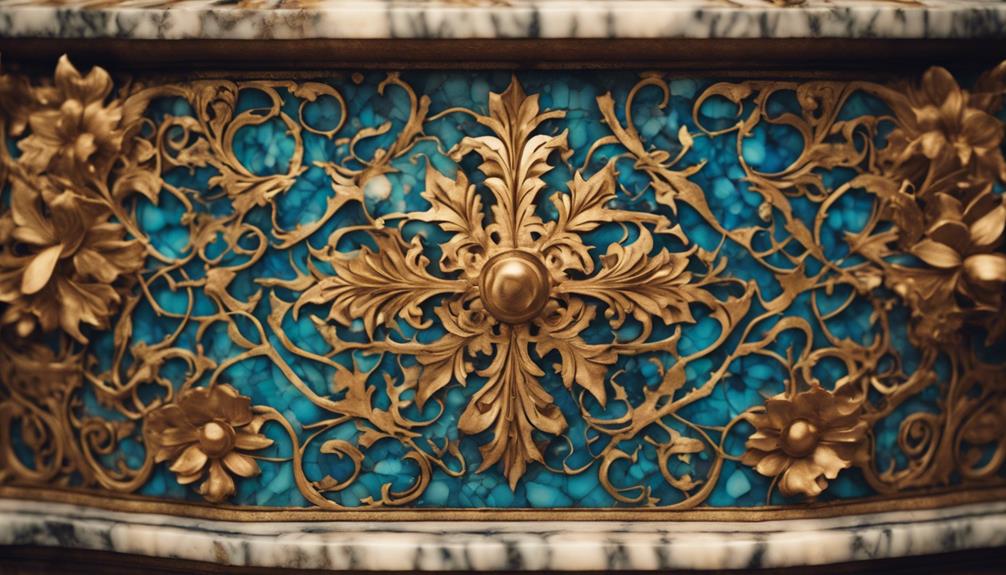
As you step into Akbar's Tomb, you're immediately struck by the stunning marble inlays that adorn the walls and ceilings. These intricate designs are a tribute to the exceptional craftsmanship of the artisans who created them. As you explore this magnificent monument, you'll want to take your time to appreciate the exquisite details that make Akbar's Tomb a true marvel of Mughal architecture.
Overview
Standing before Akbar's Tomb, you're immediately struck by the breathtaking beauty of its marble inlays, a tribute to the Mughal era's unparalleled mastery of intricate geometric patterns and floral designs. As you gaze upon the tomb's stunning white marble, adorned with precious stones like jasper, jade, and turquoise, you can't help but be mesmerized by the sheer craftsmanship on display. The Mughal history is palpable here, with the marble inlays serving as a monument to the era's exceptional artistry and cultural significance. The tomb's main chamber is a marvel, featuring a stunning marble inlay of the 99 names of Allah, showcasing the Mughal's mastery of calligraphy and geometric patterns. Despite being over 400 years old, the marble inlays have been beautifully preserved, a true wonder of Mughal architecture. As you walk through the tomb, you can't help but feel a sense of awe and reverence for the Mughal era's enduring cultural legacy.
Intricate Marble Inlay Work
Within the tomb's ornate walls, you're surrounded by a kaleidoscope of colors, as the intricate marble inlay work, crafted from over 35 precious and semi-precious stones, bursts forth in a dazzling display of Mughal mastery. The marble craftsmanship at Akbar's Tomb is truly breathtaking, with each stone carefully selected and sourced from around the world, including China, Persia, and Afghanistan. The artisans' expertise in pietra dura, a decorative art form originating in 16th-century Italy, is evident in every delicate detail.
As you marvel at the intricate designs, geometric patterns, and floral motifs, you'll notice the calligraphic inscriptions that add an extra layer of beauty to the tomb's interior. The technique of commessi di pietre dure, which involves cutting and polishing the stones to fit together seamlessly without adhesives, is a demonstration of the artisans' skill. The result is a stunning visual effect that will leave you in awe. This masterpiece of marble inlay work is a highlight of Akbar's Tomb and a must-see when visiting Agra.
Best Time To Visit
You'll want to plan your visit to Akbar's Tomb when the weather is mild and comfortable, allowing you to fully appreciate the breathtaking marble inlays without distractions. Climate consideration is essential when planning your trip to Agra. The best time to visit Akbar's Tomb is during the winter months (October to March), when the temperature ranges from 10°C to 25°C. This period is considered the peak tourist season, but it's worth braving the tourist rush for the pleasant weather. If you prefer to avoid the crowds, consider visiting during the off-season (April to September), when the weather is hot and humid. Be sure to check the weather forecast before your visit and plan accordingly. To avoid the crowds, consider visiting early in the morning or late in the evening. These timings will not only provide you with a more peaceful experience but also offer a more comfortable temperature. By planning your visit strategically, you'll be able to make the most of your time at Akbar's Tomb and truly appreciate the stunning marble inlays.
Wear Comfortable Walking Shoes
As you prepare to marvel at the intricate marble inlays of Akbar's Tomb, slip on a pair of comfortable walking shoes, because you'll be doing a lot of walking and standing on the sprawling grounds. You'll want to guarantee your feet are happy and healthy, as you explore the stunning architecture and history of this magnificent monument. A good pair of shoes will provide sole protection from the scorching sun-baked ground, and ankle support to prevent twists and sprains as you navigate the uneven terrain. With comfortable shoes, you can focus on taking in the breathtaking beauty of the tomb, without worrying about your feet. Trust us, your feet will thank you! With the right footwear, you'll be able to take your time, stop to admire the intricate carvings, and soak up the atmosphere without distraction. So, don't forget to pack those comfortable walking shoes – your feet will appreciate it!
Chini Ka Rauza Architecture
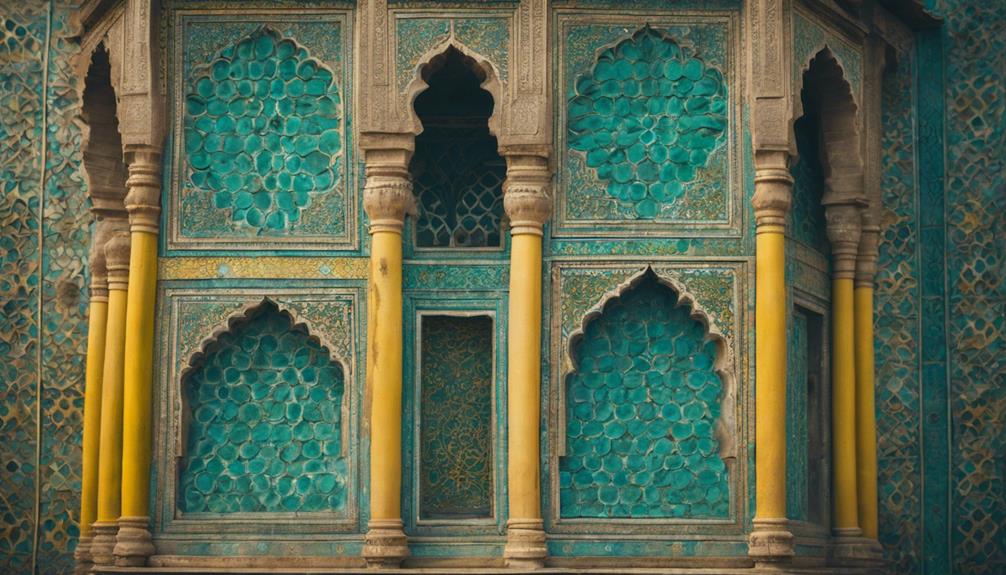
As you explore the majestic Chini Ka Rauza, you'll be struck by the intricate tile work and architectural blend of Indian, Persian, and Islamic styles. Now, let's take a closer look at the details that make this mausoleum a standout, from its stunning design to the best times to visit. Get ready to uncover the secrets of Chini Ka Rauza Architecture!
Overview
Standing majestically on the eastern bank of the Yamuna River, Chini Ka Rauza's stunning architecture is a tribute to the Mughal Empire's penchant for blending Indo-Persian styles, resulting in a unique and breathtaking monument. As you approach the mausoleum, you'll notice the striking glazed tiles that adorn its facade, giving it a distinctive appearance. This blend of styles is an enduring legacy of the Mughal Legacy, showcasing the empire's ability to merge different cultural influences into something truly remarkable. The Architectural Evolution of the Mughal Empire is evident in Chini Ka Rauza's design, which combines intricate calligraphy, ornate decorations, and beautiful tile work. As you explore the monument, you'll discover a square-shaped structure with a central chamber surrounded by eight smaller rooms, each featuring intricate carvings, ornate ceilings, and beautiful tile work. With its picturesque setting and unique architectural style, Chini Ka Rauza is a hidden gem that offers a fascinating glimpse into the Mughal Empire's rich cultural heritage.
Intricate Tile Work Design
You'll be struck by the kaleidoscope of colors and intricate patterns that dance across Chini Ka Rauza's facade, a tribute to the Mughal Empire's mastery of tile work design. As you step closer, you'll notice the intricate tile work is made up of thousands of small tiles, each measuring about 1 inch square, carefully arranged to create stunning floral and geometric patterns. The blend of Persian and Indian styles in the tile work design reflects the cultural fusion that characterized the Mughal Empire's architectural innovations.
The tile patterns are a marvel, with bright blue and yellow tiles imported from Afghanistan and Iran, respectively, adding an extra layer of exoticism to the monument. The use of color is particularly remarkable, with blue symbolizing infinity and yellow representing royalty. The intricate tile work design has been beautifully restored in recent years, ensuring that this stunning example of Mughal-era craftsmanship remains a breathtaking sight for visitors to Agra. As you gaze upon the intricate tile work, you'll be mesmerized by the kaleidoscope of colors and patterns that seem to come alive before your eyes.
Best Time To Visit
When planning your visit to Chini Ka Rauza, timing is everything, and the sweet spot is from October to March, when the weather is a perfect blend of warmth and coolness, making it ideal for exploring this stunning monument. During these months, the climate is pleasant, with average temperatures ranging from 10°C to 25°C, making it perfect for outdoor activities like sightseeing and photography. You can take leisurely strolls around the monument, enjoying the scenic views of the Yamuna River and the surrounding landscape. This is also the best time to engage in seasonal activities like picnicking or taking a romantic boat ride on the river. Climate considerations are vital when visiting Agra, and October to March is the best time to avoid the scorching heat and harsh winters. With comfortable weather, you'll be able to appreciate the intricate tile work design and ornate decorations of Chini Ka Rauza without any distractions. So, plan your visit during this period and make the most of your trip to Agra.
Avoid Crowded Afternoon Hours
As you plan your visit to Chini Ka Rauza, consider ditching the afternoon crowds and opting for a serene morning or early evening exploration, when the soft golden light accentuates the intricate tile work and ornate decorations of this stunning monument. This Rush Hour Strategy will allow you to experience the tranquility of the mausoleum, situated on the eastern bank of the Yamuna River, without the chaos of tourists. The Quiet Exploration will give you a chance to truly appreciate the Indo-Persian architecture, a blend of ornate decorations and intricate marble work. As you walk around the monument, the golden light will highlight the vibrant hues of the glazed tile work, making it a photographer's paradise. By avoiding the crowded afternoon hours, you'll be able to soak in the peaceful atmosphere and take in the stunning views of the river. Make the most of your visit to Chini Ka Rauza by planning your visit during the quieter hours, and you'll be rewarded with an unforgettable experience.
Mariam's Tomb Architecture
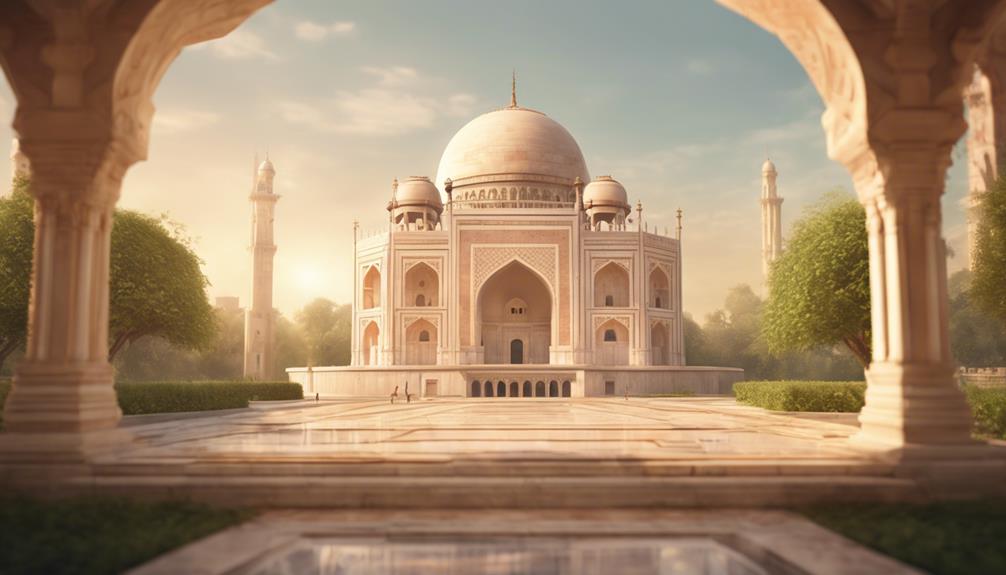
As you approach Mariam's Tomb, you'll be struck by the intricate beauty of its architecture. You'll notice the stunning marble latticework that adorns the tomb, a tribute to the skill of the craftsmen who built it. As you explore this magnificent monument, you'll want to time your visit carefully to avoid the harsh midday sun, and instead, soak up the tranquil atmosphere that pervades this historic site.
Overview
You've stumbled upon a hidden gem in Agra, Mariam's Tomb, a stunning monument to Mughal architecture that showcases the mastery of Islamic and Hindu styles. Built in 1623 by Jahangir in memory of his wife Mariam, this architectural marvel is a tribute to the Mughal history of Agra. As you approach the tomb, you'll notice the striking blend of white marble and red sandstone, a hallmark of Mughal architecture. The intricate carvings and ornate decorations that adorn the exterior walls are a demonstration of the skill of Mughal craftsmen.
As you step inside, you'll be struck by the central octagonal chamber, surrounded by eight arches and topped with a large dome, reminiscent of the Taj Mahal's architecture. The tomb's design is a perfect example of the architectural evolution that occurred during the Mughal era, where Islamic and Hindu styles merged to create a unique and breathtaking aesthetic. Mariam's Tomb is a must-visit for anyone interested in Mughal history and architecture, offering a glimpse into the region's rich cultural heritage.
Intricate Marble Latticework Design
Stepping into Mariam's Tomb, you're immediately struck by the dazzling intricate marble latticework design that adorns the walls, ceilings, and floors, a tribute to the exceptional craftsmanship of the 6,000 workers who toiled for 12 years to create this masterpiece. The tomb's marble craftsmanship is a marvel, with 53 different types of marble used, including jasper, jasperite, and various colors of marble. The intricate latticework design showcases the evolution of marble craftsmanship, blending Indian, Persian, and Islamic styles. As you walk through the tomb, you can't help but be amazed by the level of detail and precision that has gone into creating this work of art. The marble latticework design is a precursor to the more famous Taj Mahal, built later using similar techniques and design elements. The tomb's architecture is a demonstration of the expertise of the Mughal architects, who pushed the boundaries of what was possible with marble. You can't help but feel a sense of awe and wonder as you take in the beauty of Mariam's Tomb's intricate marble latticework design.
Best Time To Visit
When planning your visit to Mariam's Tomb, keep in mind that the winter season, from October to March, offers the most favorable weather conditions, making it the ideal time to appreciate the tomb's stunning architecture. The mild winter climate allows you to explore the tomb and its surroundings without the scorching heat or chilly cold, making it an ideal time for sightseeing. You'll need to pack warm winter clothing, such as light jackets and sweaters, to keep you cozy during your visit. The winter season also brings a range of seasonal activities, like attending cultural festivals and enjoying the beautiful gardens surrounding the tomb. Take your time to stroll around the courtyard, admiring the intricate marble work and ornate decorations that adorn the tomb's walls. With the pleasant weather, you'll be able to fully immerse yourself in the tranquil atmosphere of Mariam's Tomb, making your visit an unforgettable experience.
Avoid Midday Sun Exposure
As you wander through Mariam's Tomb, be mindful of the intense midday sun, which can cast harsh shadows on the intricate marble inlays, making it challenging to fully appreciate the tomb's stunning architecture. To truly soak in the beauty of this historic monument, plan your visit during the early morning or late afternoon when the sun's rays are gentler. This will allow you to marvel at the intricate carvings, ornate decorations, and delicate stone latticework without the distraction of harsh shadows.
Remember to pack your Summer Essentials, like a hat, sunglasses, and sunscreen, to protect yourself from the scorching sun. These Travel Tips will guarantee that you're comfortable and prepared for your visit. By avoiding midday sun exposure, you'll be able to fully immerse yourself in the history and grandeur of Mariam's Tomb, and take home unforgettable memories of your trip to Agra. With a little planning and preparation, you'll be able to appreciate this magnificent monument in all its glory.
Frequently Asked Questions
What Are the Unique Places to Visit in Agra?
You'll discover Agra's hidden gems, like the Itmad-Ud-Daulah's Tomb, showcasing intricate Mughal architecture, and Mehtab Bagh, offering serene views of the Taj Mahal, making your trip an unforgettable experience.
What Is Very Famous in Agra?
You'll find that Agra's fame lies in its iconic Taj Mahal, a stunning example of Mughal architecture, and its exquisite marble inlays, showcasing intricate craftsmanship that'll leave you awestruck!
Is 1 Day Enough for Agra?
"As you set foot in Agra, the ghost of Shah Jahan whispers secrets of the past. But, can you truly experience the essence of Agra in just 1 day? Prioritize your Agra itinerary, focusing on the Taj Mahal and Agra Fort, but be prepared for a whirlwind tour."
Is 2 Days Enough for Agra?
With only 2 days, you'll get a glimpse of Agra's iconic attractions, but to truly experience cultural immersion, prioritize your travel itinerary, focusing on must-see sights, and be prepared to sacrifice some hidden gems.
Conclusion
As you leave Agra, the Taj Mahal's white marble still gleams in your mind's eye, while Agra Fort's red sandstone walls echo with the whispers of the past. You've witnessed the breathtaking Mehtab Bagh sunset, and Fatehpur Sikri's royal palaces have left you awestruck. The ornate Jama Masjid, Akbar's tomb, and Chini Ka Rauza's intricate architecture will haunt your dreams, and Mariam's tomb will forever be etched in your memory – Agra has ruined you for any other travel experience!
